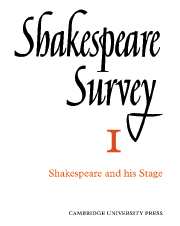Book contents
- Frontmatter
- Studies in the Elizabethan Stage since 1900
- Titus Andronicus on the Stage in 1595
- A Note on the Swan Theatre Drawing
- The Bankside Theatres: Early Engravings
- Shakespeare and the Blackfriars Theatre
- Shakespeare’s Bad Poetry
- The Folger Shakespeare Library
- The Heritage of Shakespeare’s Birthplace
- Three Shakespearian Productions: A Conversation
- Four Lears
- London Productions
- Stratford Productions
- International News
- The Year's Contributions to Shakespearian Study 1 Critical Studies
- 2 Shakespeare’s Life and Times
- 3 Textual Studies
- Books Received
- Index
- Plate section
The Bankside Theatres: Early Engravings
Published online by Cambridge University Press: 28 March 2007
- Frontmatter
- Studies in the Elizabethan Stage since 1900
- Titus Andronicus on the Stage in 1595
- A Note on the Swan Theatre Drawing
- The Bankside Theatres: Early Engravings
- Shakespeare and the Blackfriars Theatre
- Shakespeare’s Bad Poetry
- The Folger Shakespeare Library
- The Heritage of Shakespeare’s Birthplace
- Three Shakespearian Productions: A Conversation
- Four Lears
- London Productions
- Stratford Productions
- International News
- The Year's Contributions to Shakespearian Study 1 Critical Studies
- 2 Shakespeare’s Life and Times
- 3 Textual Studies
- Books Received
- Index
- Plate section
Summary
By the end of the sixteenth century there were four theatres in Southwark: (1) the Beargarden, rebuilt after its much publicized collapse in 1583, (2) the Rose, built by Henslowe in 1587 or 1588, (3) the Swan, built by Francis Langley probably in 1595, and (4) the first Globe, built by the two Burbages, Shakespeare, Heminges and others in the first half of 1599. About their sites and shapes there has been much controversy and attempts have been made to reconstruct the design of each. Unfortunately, these discussions are all vitiated by uncritical acceptance of certain Jacobean and Caroline engravings. The pictorial and documentary information about the Southwark playhouses must be considered as a whole before we can safely draw from part of it inferences about any one building; through lack of such general study erroneous assertions are current about every one of these theatres. This article is an attempt to survey the pictorial evidence, and to collate it with the relevant documentary data.
First, it is essential to determine the date and authenticity of various views and maps often put forward as evidence. A single example will serve to show the worthlessness of some of these. One view of Southwark and London that has frequently been reproduced is illustrated in Plate XII: although unsigned and undated, it has been commonly stated to belong to a period about 1604-5. Cursory examination of its portrayal of the Tower, London Bridge and St Paul's, not to mention other glaring errors, should have made it immediately suspect. It is in fact a rehash of the background of an engraved portrait (not Delaram's) of James I on horseback, unsigned but dated 1621, of which Plate XI reproduces the lower portion. Comparison will show that the engraver of the view has drawn on his imagination for those parts of the background masked by the horse's legs and tail in the portrait. Judging by its wild inaccuracy, the view was made far from London and Londoners, probably abroad. It must be later than 1621, and is worthless as topographical evidence.
- Type
- Chapter
- Information
- Shakespeare Survey , pp. 25 - 37Publisher: Cambridge University PressPrint publication year: 1948
- 1
- Cited by

